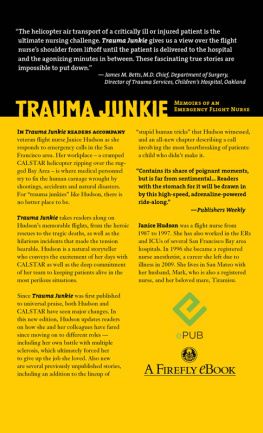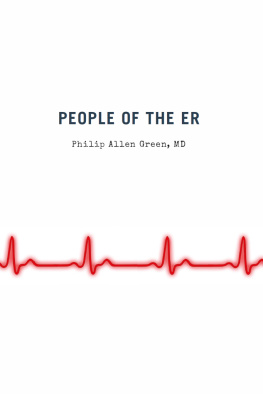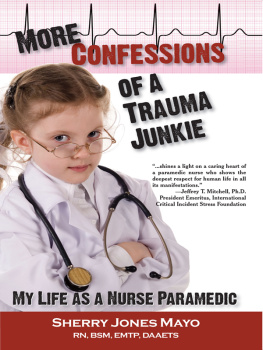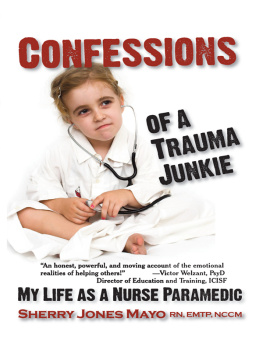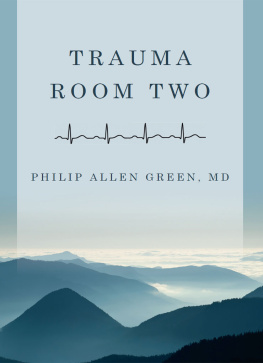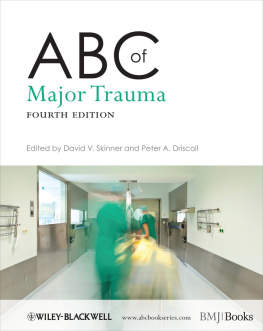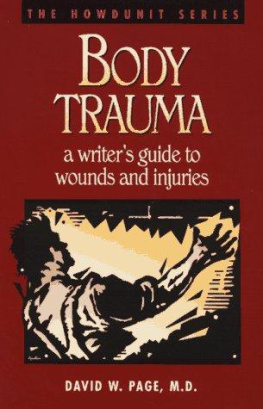

?

In 1987, I left a full-time job in the Seton Medical Center emergency department to take a position with California Shock/Trauma Air Rescue (CALSTAR), an air ambulance service in the San Francisco Bay Area. At the time, this was an emerging field and CALSTAR was only three years old. I became enamored with the flying and, though I continued to do shift work in the ER, that was only a sideshow. My true love was the helicopter.
After three years of flying, I attended a stress debriefing class that was developed to help medical professionals cope with the awful spectacles we face on the job. One of the suggestions was to keep a journal as a way of dealing with the emotional pain. So I started to writethen I wrote some more. Stories started pouring out on paper. At first they were the horrible flights, usually involving children. Then came the amazing calls, the ones with remarkable circumstances or unusual interventions. Finally there were the ludicrous stories that were so absurd we came home laughing. I enjoyed my little hobby, and slowly the material began to pile up.
In 1994, I felt it was time to grow up and get a real job. Somehow I couldnt see being fifty and still making a living scraping drunks off the freeway. With the support of my husband, Mark, I returned to graduate school, and after two nightmarish years I emerged with a Masters degree and became a full-time certified registered nurse anesthetist.
I loved my new profession, but I still wistfully remembered those wonderful years with CALSTAR. I missed the breakneck pace of caring for critical trauma patients, and I missed the people I worked with. The relationships we shared were absolutely professional, yet intensely intimate at the same time. CALSTAR had been an extended family, complete with bratty brothers and occasional spats that put us all on edge. Our work brought us all close together in a club that no one could really understand unless they had been part of it.
As I settled into my new career, my journal collected dust. Occasionally I would share stories with friends and co-workers, and over and over they suggested I make them into a book. My family has a long history of writers: my grandfather and great uncle were newspaper editors in Philadelphia, and my father wrote for professional reasons, so I suppose the gene was passed down to me. But I wasnt sure. I had a pile of stories, but I didnt know if I could turn them into a real book, and I had no idea how to get published.
I went to our local library to do some research. I soon learned how rare it is for an unknown writer to even get the attention of a publisher. The largest houses wont even consider a manuscript without an agent, and its hard to get an agent if you havent already been publisheda classic catch-22. Undeterred, I pored through a directory and sent letters to several publishers who I felt might consider a non-fiction medical book from a first-time writer.
Several weeks later, I came home after a long and exhausting day in the OR. The phone rang, and a gentleman asked if I was Janice Hudson. Thinking it was a telemarketer, I responded bluntly. Yes, this is she. And what do you want?
It turned out to be Lionel Koffler, the president of Firefly Books, and he said he was interested in seeing my manuscript. Lionel explained how just that week he had told his staff he wanted to publish a book about emergency medical services (EMS). At the time, the television show ER was hot, and so was a reality program on The Learning Channel that was set in a busy urban emergency department. Amazingly, my letter had hit Lionels desk at exactly the right time.
There was still one problem, though. The manuscript was, to be gracious, a mess. When I had written my journal, I had no idea that someday it might be read by anyone other than myself. It soon became clear that wed either need a ghostwriter or an editor who could help me polish the stories in my journal. Lionel decided on the latter: he felt it would be best to preserve my voice and make readers feel like Im telling a story over coffee. Lionel gave the task to Dan Bortolotti, and the two of us started work right away.
I was trying to fit the rewriting into a forty-hour-plus work week, and Dan had a full-time job at a magazine, so we often ended up on the phone till midnight. Eventually we cobbled together a manuscript, and Firefly flew me to Toronto to do some final editing and photo selection. During my visit I made an offhanded comment about flight nurses: Aw, were just a bunch of trauma junkies. Lionel laughedand we had our title. The first edition of Trauma Junkie was released in March 2001.
Over the years, Trauma Junkie has lived on, and its brought me a small measure of celebrity in the EMS community. On a recent trip to Gilroy, I noticed that CALSTAR was flying a Notara swanky new helicopter with no tail rotor. After years of working there, I knew it was inappropriate to just walk up to the helicopter and start poking around, so Mark and I went over to quarters to ask permission. Of course, I didnt know anyone there, but I expected they would be like all flight crews, who hate when people just show up at the door and force them to put on their PR faces. Sure enough, the pilot answered the door looking annoyed. Hi, I said. My name is Janice Hudson. I used to work here. I dont want to bother you, but we saw the Notar and I was wondering if it would be OK to take a look.
In the background, I heard a woman squeal. Is that Janice Hudson? Oh, my God, I just finished her book! Apparently she was a new flight nurse, and shed been assigned Trauma Junkie as part of her preparation for the field. Ive since learned that other air ambulance programs have also made it required reading for new recruits.
I hadnt thought much about the book in recent years. Firefly had moved to a new location and my main contact had left. In the summer of 2009, however, I called them to order some copies to give as gifts.
Were out of stock, said the clerk at the order desk. Well, thats it, I thought. It was fun while it lasted, but it seemed like this was the end of Trauma Junkie .
Do you know if theyre planning a reprint? I ventured.
I have no idea, but Ill transfer you to someone who might know.
I left a message on the voicemail of a woman I had never heard of. Less than an hour later, Lionel Koffler himself called me back. Were so glad to hear from you, were his first words. We thought you were dead.
As we talked, we figured out the confusion. Lionel knew I had been diagnosed with cancer not long after the first edition came out. During my treatment, I wasnt feeling real communicative, and we had lost touch. Their records had transposed two digits in my phone number and I had changed my email address. Unable to reach me, they feared the worst. The must have thought Mark, my grieving widower, was cashing my royalty checks.
Once again, it seemed I had contacted Firefly at the perfect time. Trauma Junkie had sold out and Lionel wanted to release a new edition. They wanted to know if I had any new material to add, and as it happens, there were a couple of stories in my little journal that didnt make it into print the first time around. I was reunited with Dan, my editor, and together we wove those new stories into the book. Weve added a new chapter, You Mean Were Not Omnipotent?, and an afterword with updates on the lives of some of the people youll meet in the book, as well as an account of my personal journey in the years since Trauma Junkie first appeared.
Next page
